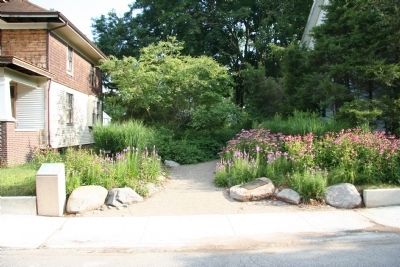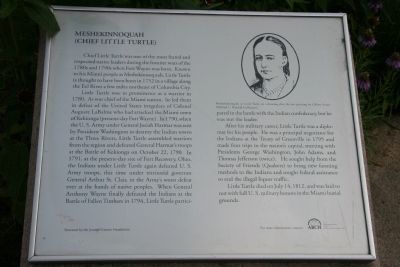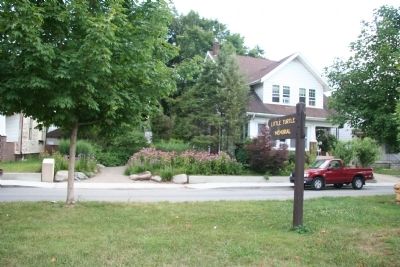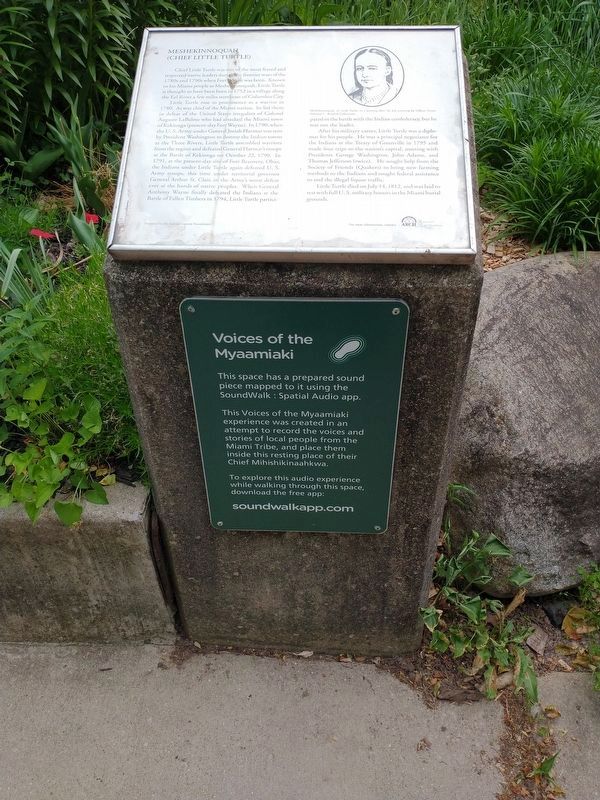Spy Run in Fort Wayne in Allen County, Indiana — The American Midwest (Great Lakes)
Meshekinnoquah
(Chief Little Turtle)
Little Turtle rose to prominence as a warrior in 1780. As war chief of the Miami nation, he led them in defeat of the united States irregulars of Colonel LaBalme who attacked the Miami town of Kekionga (present-day Fort Wayne). In 1790, when the U.S. Army under General Josiah Harmar was sent by President Washington to destroy the Indian towns at the Three Rivers, Little Turtle assembled warriors from the region and defeated General Harmar's troops at the Battle of Kekionga on October 22, 1790. In 1791, at the present-day site of Fort Recovery, Ohio, the Indians under Little Turtle again defeated U.S. Army troops, this time under territorial governor General Arthur St. Clair, in the Army's worst defeat ever at the hands of native peoples. When General Anthony Wayne finally defeated the Indians at the Battle of Fallen Timbers in 1794, Little Turtle participated in the battle with the Indian confederacy, but not as the leader.
After his military career, Little Turtle was a diplomat for his people. He was a principal negotator for the Indians at the Treaty of Greenville in 1795 and made four trips to the nation's capital, meeting with Presidents George Washington, John Adams, and Thomas Jefferson (twice). He sought help from the Society of Friends (Quakers) to bring new farming methods to the Indians and sought federal assistance to end the illegal liquor traffic.
Little Turtle died on July 14, 1812, and was laid to rest with full U.S. military honors in the Miami burial grounds.
Erected by the Journal-Gazette Foundation.
Topics and series. This historical marker is listed in these topic lists: Cemeteries & Burial Sites • Native Americans • Wars, US Indian. In addition, it is included in the Former U.S. Presidents: #01 George Washington, the Former U.S. Presidents: #02 John Adams, the Former U.S. Presidents: #03 Thomas Jefferson, and the Quakerism series lists. A significant historical month for this entry is July 1863.
Location. 41° 5.484′ N, 85° 7.937′ W. Marker is in Fort Wayne, Indiana, in Allen County. It is in Spy Run. Marker is on Lawton Place, 0.1 miles east of Spy Run Avenue, on the right when traveling east. This historical marker is located about 0.5 miles due north of the point where the St. Mary's and St. Joseph's Rivers come together to form the Maumee River.

Photographed By Dale K. Benington, July 20, 2009
2. Meshekinnoquah Marker
View of historical marker in the left foreground, with a view of a second marker, the plaque to dedicated to Chief Little Turtle affixed to the large flat rock in the center foreground of the picture. Both markers being located at the site of Chief Little Turtle's final resting place.
Other nearby markers. At least 8 other markers are within walking distance of this marker. Chief Little Turtle (here, next to this marker); Site of Last French Fort (approx. 0.2 miles away); William Wells (approx. 0.2 miles away); Civil War Memorial (approx. 0.2 miles away); Home of Philo T. Farnsworth (approx. 0.4 miles away); The "State School" (approx. 0.4 miles away); Duck Creek: Early Industry and Business Development (approx. half a mile away); Emerine Jane Holman Hamilton (approx. half a mile away). Touch for a list and map of all markers in Fort Wayne.
Also see . . . Wikipedia entry for Michikinikwa. (Submitted on August 9, 2009, by Dale K. Benington of Toledo, Ohio.)
Credits. This page was last revised on June 19, 2023. It was originally submitted on August 9, 2009, by Dale K. Benington of Toledo, Ohio. This page has been viewed 2,341 times since then and 28 times this year. Photos: 1, 2, 3. submitted on August 9, 2009, by Dale K. Benington of Toledo, Ohio. 4. submitted on June 13, 2023, by Tom Bosse of Jefferson City, Tennessee. • Craig Swain was the editor who published this page.


